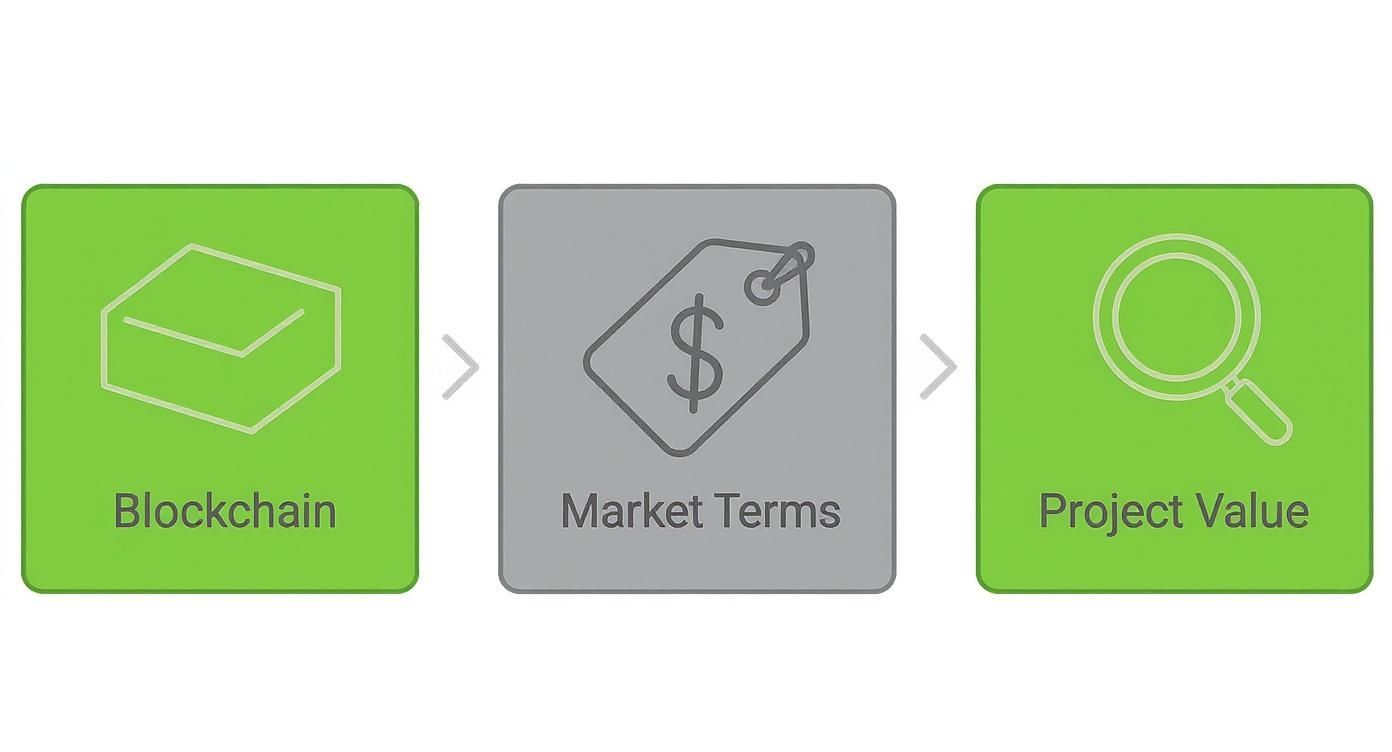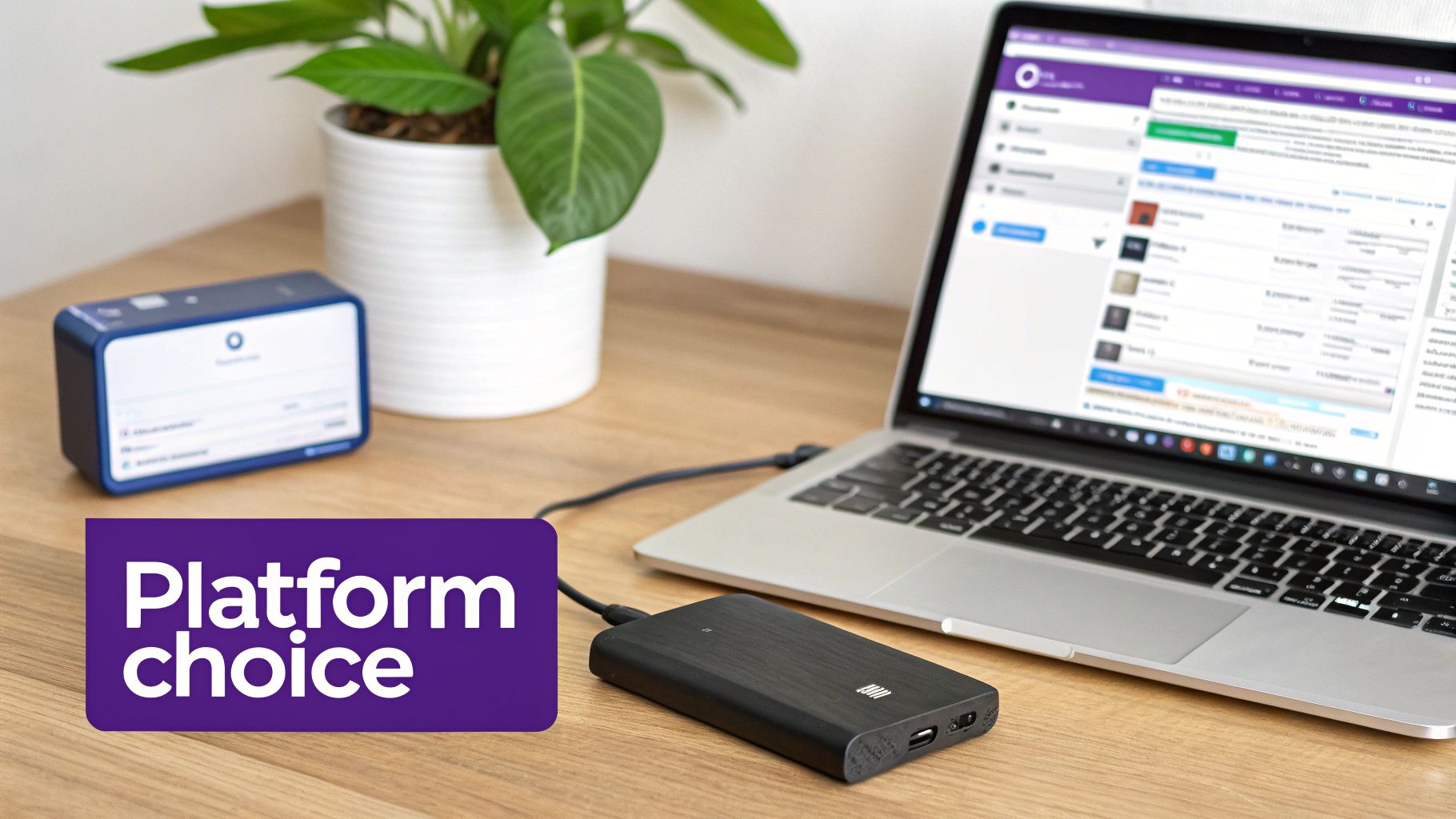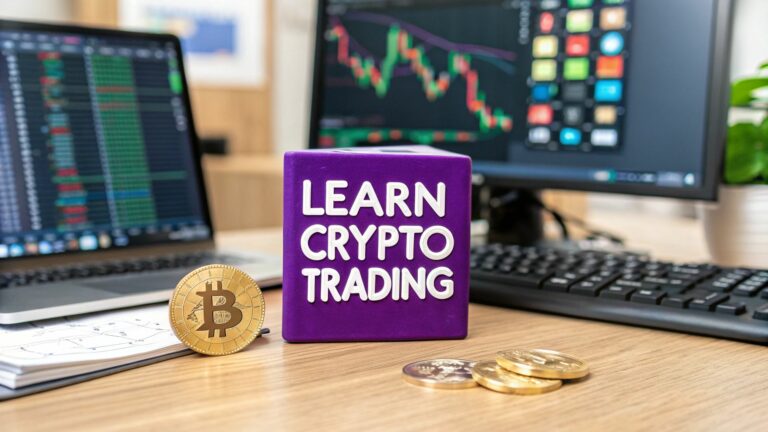Learning how to trade crypto isn't just about memorizing chart patterns. It's a disciplined process. You have to start with the fundamentals, practice in a safe environment like a demo account, and build a solid strategy before you even think about putting real money on the line.
The goal is education first, profits second. True success in this game comes down to mastering risk management and keeping your emotions in check when the market gets chaotic.
Starting Your Crypto Trading Journey The Right Way

Jumping into crypto trading can feel like trying to drink from a firehose. Between the candlestick charts, the technical jargon, and the constant noise on social media, it's easy to get overwhelmed.
Before you get lost, it’s critical to build a realistic foundation. This isn't about chasing the "buy low, sell high" dream. It's about understanding a deeply volatile market and developing the right mindset to survive and thrive long-term.
The interest in crypto has exploded. By 2025, it's estimated that 28% of American adults will own some form of cryptocurrency, a figure that has almost doubled since 2021. But here's the catch: a recent study from Security.org revealed that 40% of crypto owners are worried about platform security. This just highlights how crucial proper education is.
Setting Realistic Expectations
Too many newcomers get lured in by stories of people getting rich overnight. The hard truth? Successful trading is a skill you build over time. It demands patience, discipline, and a genuine commitment to keep learning.
Think of your first year not as a sprint to get rich, but as an apprenticeship.
Here are the core principles you need to adopt from day one:
- Education Over Speculation: Your main goal should be to learn, not just to earn. Focus on understanding why the market moves the way it does instead of just gambling on its next direction.
- Risk Comes First: Before you even calculate potential profits, you must have a plan for managing potential losses. This is the single biggest thing that separates pro traders from those who blow up their accounts.
- Discipline is Your Superpower: The market will play with your emotions, throwing fear and greed at you constantly. A disciplined approach, guided by a clear strategy, is your best defense against making impulsive, costly mistakes.
The most successful traders aren't gamblers; they're meticulous planners who treat trading like a business. They know that consistent profits come from a structured, educated approach, not from getting lucky on one trade.
Our goal here is to cut through the hype and give you a clear roadmap. From the basics of blockchain to the psychology of the market, building a strong foundation is non-negotiable.
For structured lessons and practical exercises to speed up your learning, check out the resources available in the vTrader Academy.
Building Your Foundational Crypto Knowledge
Real success in crypto trading isn’t about luck or hype—it’s built on a solid understanding of the market. Too many new traders jump straight to analyzing charts, chasing price movements without knowing what they're actually buying. That’s a recipe for disaster.
Think of it like this: you wouldn't buy stock in a tech company without knowing what its product does, who its competitors are, or what problem it solves. The same logic applies directly to crypto. Every coin and token is tied to a project with specific technology, goals, and a community driving it.
This might be why education level often correlates with crypto adoption. In 2025, data shows that over half (52%) of crypto users worldwide have at least a bachelor's degree. In the US, that number jumps to 62% of crypto investors being college-educated. It suggests that people comfortable with research and analysis feel better equipped to tackle crypto's complexities.
From Blockchain to Market Dynamics
Before you can trade effectively, you have to get a grip on the core concepts that make a cryptocurrency work. Don’t just memorize definitions; focus on how they impact trading.
- Blockchain Technology: This is the decentralized ledger that records every transaction. For a trader, understanding a project’s blockchain helps you evaluate its security, speed, and scalability—all critical factors for long-term value.
- Consensus Mechanisms (PoW vs. PoS): Bitcoin runs on Proof of Work (PoW), which is incredibly secure but uses a lot of energy. Many newer projects use Proof of Stake (PoS), which is more efficient and often lets you earn staking rewards. Knowing the difference helps you judge a project's sustainability and even its potential for passive income.
- Tokenomics: This is the economics behind a token—its supply, how it's distributed, and what it’s used for. A project with a fixed supply like Bitcoin (21 million coins) has completely different value drivers than one with an inflationary model.
Understanding a project’s tokenomics is like reading a company's financial statement. It reveals the supply and demand dynamics that ultimately move the price. Scarcity is a powerful driver of value, so a limited supply is often a strong bullish signal.
Practical Market Concepts for Traders
Once you’ve got the tech basics down, it’s time to learn the language of the market. These aren't just abstract terms; they are practical tools that explain what’s happening with the price. A great way to start is to explore different crypto assets and see these concepts in action.
Take liquidity, for instance. A crypto with high liquidity means there's a lot of trading activity. You can buy or sell large amounts without moving the price too much. Low-liquidity altcoins are the opposite—a single large trade can send the price soaring or crashing, making them much riskier.
Another key tool is the order book. This is just a live list of all the buy and sell orders for a crypto on an exchange. By watching it, you can see where big pockets of buying pressure (support) and selling pressure (resistance) are building up. It gives you a raw, unfiltered look at what the market is thinking.
Watching how others apply these concepts can also dramatically speed up your learning curve, which is where social learning principles come in handy. Engaging with experienced traders online can make these foundational topics click much faster.
Learning the Essentials of Trading Analysis
Alright, you’ve got a handle on the crypto basics. Now it's time to shift from just knowing what crypto is to understanding how to trade it. This is where you learn the two core methods every single trader relies on to decide when to pull the trigger on a buy or sell.
These aren’t just textbook theories; they're the practical frameworks you'll use to spot real opportunities.
The two main schools of thought are fundamental analysis (FA) and technical analysis (TA). Some traders swear by one, but I’ve found the most consistently successful people blend insights from both. If you want to build a well-rounded view of the market, you need to get comfortable with both.
This decision tree gives you a great visual of the path, from understanding the tech to actually valuing a project.

As you can see, you can't properly value a project without first understanding the "what" (blockchain) and the "how" (market terms). It all builds on itself.
Dissecting a Project with Fundamental Analysis
Fundamental analysis is basically detective work. Your goal is to figure out a cryptocurrency's real intrinsic value. You dig deep into the project itself to determine if the market is overvaluing or undervaluing it. You’re trying to answer one big question: "Is this project genuinely useful and built to last?"
To do this right, you have to look into a few key areas:
- The Whitepaper: This is the project's blueprint. It lays out the problem it's trying to solve, the tech it uses, and the long-term vision. A clear, well-written whitepaper is a huge green flag.
- The Team: Who’s actually building this thing? I always look for experienced developers, sharp business minds, and credible advisors. A transparent team with a solid track record gives a project instant credibility.
- Tokenomics: This is just a fancy word for the token's economic system. You need to know its total supply, how tokens are distributed, and what it’s actually used for. A token with a real purpose and a limited supply is a classic recipe for value.
- Community and Adoption: Is anyone actually using this? A buzzing community on Discord or X (formerly Twitter) and real-world partnerships are powerful signs that a project is gaining momentum.
A project with rock-solid fundamentals might not pump overnight. But its real-world value is what fuels sustainable, long-term growth. Never mistake a low price for a good value without doing your homework first.
Reading the Market with Technical Analysis
While FA is about a project's long-term health, technical analysis (TA) is all about price and volume. TA traders believe that everything you need to know is already reflected on the price chart. They hunt for patterns and trends to predict where the price might go next.
TA can look pretty intimidating at first with all its squiggly lines, but you can start with just a few core concepts. To see these ideas in action, pull up a tool like vTrader's Bitcoin price prediction chart and look at the historical data as you learn.
Here are the building blocks of TA:
- Price Charts: You'll almost always be looking at candlestick charts. Each "candle" tells you the open, high, low, and close price for a set time period (like a day or an hour).
- Support and Resistance: These are the price levels where the market has historically hit a wall or found a floor. Support is a price level where buyers tend to step in, and resistance is a ceiling where sellers usually take over.
- Moving Averages (MA): An MA smooths out all the noise in the price action to help you see the underlying trend more clearly. A classic bullish signal is when a short-term MA (like the 50-day) crosses above a long-term MA (like the 200-day).
To make it even clearer, let's break down the core differences between these two approaches.
Fundamental vs Technical Analysis A Quick Comparison
Think of FA as the "why" and TA as the "when." One isn't necessarily better than the other; they just answer different questions. This table should help you see where each one shines.
| Aspect | Fundamental Analysis (FA) | Technical Analysis (TA) |
|---|---|---|
| Core Focus | A project's intrinsic value and long-term potential. | Historical price action, chart patterns, and trading volume. |
| Key Questions | Is this project undervalued? Does it solve a real problem? | Where is the price likely to go next? What are key entry/exit points? |
| Time Horizon | Long-term (weeks, months, years). | Short- to medium-term (minutes, hours, days, weeks). |
| Tools Used | Whitepapers, team bios, tokenomics, community sentiment. | Candlestick charts, indicators (RSI, MACD), moving averages. |
| Primary Goal | Identify assets with strong long-term growth potential. | Capitalize on short-term price movements and market trends. |
Ultimately, using both gives you a much fuller picture. FA helps you find a solid project worth investing in, while TA helps you time your entry and exit for better results.
Crafting Your Personal Trading Strategy
https://www.youtube.com/embed/6azv_c5V_3I
Trading without a plan is just gambling. I’ve seen it a thousand times: someone gets a few lucky wins, feels invincible, and then gets wiped out when the market turns. It’s a recipe for disaster.
After you’ve got the fundamentals down, your next job is to build a strategy that actually fits your life—your goals, how much risk you can stomach, and how much time you have. This isn't about chasing some magic formula you found on YouTube. It's about building a disciplined framework for making smart decisions.
A huge mistake I see new traders make is copying someone else’s strategy without thinking it through. What works for a full-time day trader glued to their screen is going to be a terrible fit for someone with a 9-to-5 who can only check charts at night. The goal is to create a system you can stick with, especially when things get chaotic and your emotions start screaming at you.
Define Your Trading Style
First things first, you need to decide what kind of trader you want to be. This dictates how often you’ll trade and for how long you’ll hold your positions. It’s the foundation of everything else. It’s worth exploring the various investment strategies in cryptocurrency to see what clicks.
There are really three main approaches:
- Day Trading: This is the most intense style, involving multiple trades within a single day. The goal is to scalp small profits from short-term price moves. It requires constant attention and is not for the faint of heart.
- Swing Trading: These traders aim to capture larger market “swings” by holding positions for several days or even weeks. It requires less screen time than day trading but still demands consistent analysis.
- Position Trading (or HODLing): This is the long game. You hold assets for months or years based on a strong belief in the project’s fundamentals. It’s the most hands-off approach of the three.
Be honest with yourself. If you have a demanding job and a family, day trading is probably off the table. Pick a style that fits your real-world schedule and personality.
Building Your Personal Trading Plan
A trading plan is your rulebook. It’s what separates disciplined trading from emotional gambling. You need to write it down—every single rule—so you have something to fall back on when the pressure is on.
Your trading plan is your business plan. It outlines every decision, from entry to exit, so that you operate with logic, not fear or greed. A well-defined plan is the single greatest tool for managing risk.
Here’s what every solid trading plan needs to cover, no exceptions:
- Entry Rules: What exactly needs to happen for you to open a trade? This could be a specific technical signal, a price breaking through a key level, or a major news event. Be precise. "The price looks like it's going up" is not a rule.
- Exit Rules (Profit): When will you take your profits? Is it at a specific price target? Or when an indicator signals the trend might be reversing? Don't let greed turn a great trade into a losing one.
- Exit Rules (Loss): Where is your stop-loss? This is the most critical rule of all. A stop-loss is an order that automatically closes your position if the price drops to a certain level, protecting you from a catastrophic loss. A standard rule of thumb is to never risk more than 1-2% of your entire portfolio on a single trade.
- Position Sizing: How much money will you put into each trade? This goes hand-in-hand with your stop-loss and the 1-2% rule. Proper sizing ensures that one bad trade doesn't blow up your account.
Don't forget to factor in trading costs. While vTrader offers zero-commission trading, you still need to be aware of any potential crypto network or transaction fees to calculate your true profit and loss. A good plan forces you to see the entire picture, not just the price chart.
Choosing Your Tools and Platforms Wisely

Your trading setup is every bit as important as your strategy. It doesn't matter how brilliant your plan is if you’re fighting a clunky, high-fee, or insecure platform. This is where your knowledge meets the live market, so getting your tools right is non-negotiable.
The crypto world is moving faster than ever. Regulatory shifts in 2025 have already changed the game, and with a global market cap now topping $3.5 trillion, the stakes are higher. Big players are here, with institutional money pouring in—we saw nearly $6 billion flood into crypto ETFs in just one week.
This new environment demands better tools. You can get a deeper look into what this means for the market in 2025's crypto trading forecast on bjftradinggroup.com.
Selecting a Secure Crypto Exchange
Your exchange is your gateway to the market. When you're starting out, forget the flashy, complex features and focus on two things: security and usability. Find a platform with a solid track record and a reputation for protecting its users.
Here’s what I look for when evaluating an exchange:
- Security Protocols: Two-factor authentication (2FA) is a must, no exceptions. Also, confirm they keep the vast majority of assets in cold storage (offline). This is the industry gold standard.
- Regulatory Compliance: Is the platform registered with major regulatory bodies like FinCEN in the U.S.? This isn't just about ticking a box; it shows they're serious about legal and security standards.
- User Experience: The interface has to be clean and intuitive. A confusing layout is a recipe for disaster and can lead to expensive mistakes, like placing the wrong type of order.
Understanding Essential Order Types
Once you’re set up on an exchange, you need to know how to place a trade. The two most basic orders you’ll use are market orders and limit orders.
A market order is the "buy it now" button. It executes your trade immediately at the best price available. It’s fast and guarantees your order gets filled, but in a volatile market, the price you get might not be the price you saw a second ago.
A limit order, on the other hand, gives you control. You set the exact price you're willing to buy or sell at. The trade only goes through if the market hits your number. This is great for precision, but there’s no guarantee your order will ever get filled if the price never reaches your target.
As a beginner, stick to limit orders. It’s an incredible tool for building discipline. It forces you to define your entry and exit points ahead of time instead of just impulsively chasing a pump.
The Non-Negotiables of Wallet Security
At the end of the day, protecting your crypto is your job. Exchanges are great for trading, but they are also a huge target for hackers. Never leave a significant amount of crypto on an exchange long-term.
Hardware wallets (often called "cold wallets") are the answer. These are small physical devices that keep your private keys completely offline, making them untouchable by online threats. Think of it as your personal vault.
And one last thing: don't forget about transaction costs. Moving assets on-chain can get expensive when the network is busy. Using a good ETH Gas Tracker can save you a surprising amount of money by helping you avoid peak-fee times.
A Few Common Questions From New Traders
If you’re just getting started, you probably have a million questions. That’s a good thing. It means you’re thinking critically. Let's clear up a few of the most common ones right away so you can begin with a solid, realistic mindset.
How Much Money Do I Actually Need to Start?
Honestly, not much. Most exchanges will let you get your feet wet with as little as $10 or $20.
The goal when you’re new isn't to get rich overnight. It's to learn the ropes—how to place a trade, set a stop-loss, and manage your emotions—without getting burned. Think of that first deposit as your tuition fee for the real world of trading.
The most important rule? Never invest more than you are truly comfortable losing. Master your strategy first. The bigger money can wait.
What's the Single Most Important Skill to Learn First?
It's not chart patterns or fancy indicators. The single most crucial skill is risk management.
The crypto market is notoriously volatile. Your first job isn't to make money; it's to protect the capital you have. If you run out of capital, you're out of the game.
Nail down these habits, and you'll be ahead of 90% of beginners:
- Always Set Stop-Losses: This is non-negotiable. A stop-loss is your automatic eject button that sells your position at a set price to cap your losses.
- Manage Your Position Size: A golden rule is to never risk more than 1-2% of your entire trading account on one trade. This way, a single bad call won’t wipe you out.
- Trade Like a Robot (In a Good Way): Fear and greed will destroy your account faster than anything. Stick to your trading plan, no matter how you feel.
Professionals are risk managers first and traders second. They focus on survival because they know profits follow discipline. Gamblers just chase the big score with no safety net. Don't be a gambler.
Realistically, How Long Does It Take to Learn This?
There’s no magic number. It all comes down to your dedication and how much time you can put in. Some people start feeling comfortable after a few months of focused effort, while for others, it might take a year or more to find their groove.
Ditch the "get rich quick" fantasy. Trading is a marathon, not a sprint.
The real goal should be steady, consistent improvement. Practice on a demo account or with tiny amounts of real money. Focus on building solid habits, not on hitting home runs your first week. Profitability is what happens after you’ve put in the work and developed discipline and experience.
Ready to put your knowledge into action with zero-fee trading? Join vTrader today, get a $10 sign-up bonus, and start building your portfolio on a platform designed for both new and experienced traders. Explore advanced tools, educational resources, and a secure trading environment.

Steve Gregory is a lawyer in the United States who specializes in licensing for cryptocurrency companies and products. Steve began his career as an attorney in 2015 but made the switch to working in cryptocurrency full time shortly after joining the original team at Gemini Trust Company, an early cryptocurrency exchange based in New York City. Steve then joined CEX.io and was able to launch their regulated US-based cryptocurrency. Steve then went on to become the CEO at currency.com when he ran for four years and was able to lead currency.com to being fully acquired in 2025.


